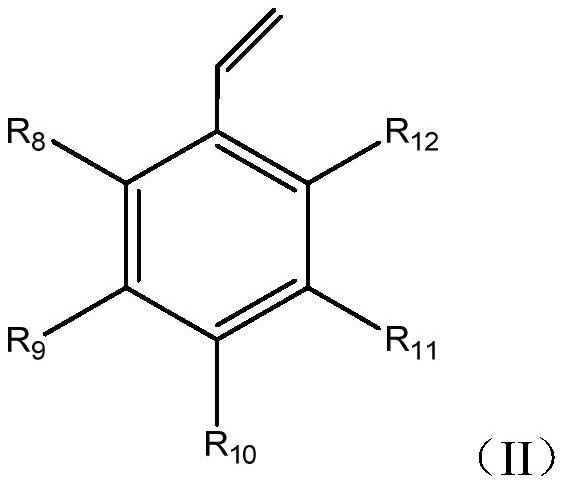Polymethyl methacrylate polymer and preparation method thereof
A technology of polymethyl methacrylate and methyl methacrylate is applied in the field of heat-resistant reinforced polymethyl methacrylate monomer and its preparation, and achieves environmental protection, low energy consumption, guaranteed product quality, and good light transmittance. Effect
- Summary
- Abstract
- Description
- Claims
- Application Information
AI Technical Summary
Problems solved by technology
Method used
Image
Examples
Embodiment 1
[0058] Steps:
[0059] (1) Ingredients: take 80 parts of monomer I methyl methacrylate, 14 parts of monomer II vinyl monomer containing triphenyl structure, 6 parts of monomer III p-divinylbenzene, initiator diphenyl peroxide 0.18 part of formyl, 0.15 part of chain transfer agent tert-dodecyl mercaptan, fully stirred until they were mixed evenly, added to the reaction kettle, and passed nitrogen for 20 minutes to remove the oxygen dissolved in it;
[0060] (2) Step-by-step polymerization: control the reaction temperature to 90°C, react under stirring for 40min, move the polymer in the reactor into a low-temperature reaction vessel, control the reaction temperature to 50°C, and the reaction time to 32h, and further heat up to 90°C, 105°C, 120 ° C, each temperature was reacted for 2 hours, the polymerization conversion rate was improved, and the residual monomer was reduced.
Embodiment 2
[0062] Steps:
[0063] (1) batching: take 85 parts of monomer I methyl methacrylate, 9 parts of monomer II vinyl monomer containing triphenyl structure, 6 parts of monomer III p-divinylbenzene, initiator diphenyl peroxide 0.18 part of formyl, 0.15 part of chain transfer agent tert-dodecyl mercaptan, fully stirred until they were mixed evenly, added to the reaction kettle, and passed nitrogen for 20 minutes to remove the oxygen dissolved in it;
[0064] (2) Step-by-step polymerization: control the reaction temperature to 90°C, react under stirring for 40min, move the polymer in the reactor into a low-temperature reaction vessel, control the reaction temperature to 50°C, and the reaction time to 32h, and further heat up to 90°C, 105°C, 120°C, respectively, at each temperature for 2 hours to increase the polymerization conversion rate.
Embodiment 3
[0066] Steps:
[0067] (1) Ingredients: take 90 parts of monomer I methyl methacrylate, 6 parts of monomer II vinyl monomer containing triphenyl structure, 4 parts of monomer III p-divinylbenzene, initiator diphenyl peroxide 0.18 part of formyl, 0.15 part of chain transfer agent tert-dodecyl mercaptan, fully stirred until they were mixed evenly, added to the reaction kettle, and passed nitrogen for 20 minutes to remove the oxygen dissolved in it;
[0068] (2) Step-by-step polymerization: control the reaction temperature to 90°C, react under stirring for 40min, move the polymer in the reactor into a low-temperature reaction vessel, control the reaction temperature to 50°C, and the reaction time to 32h, and further heat up to 90°C, 105°C, 120 ° C, respectively, at each temperature for 2 hours to reduce residual monomers.
PUM
| Property | Measurement | Unit |
|---|---|---|
| glass transition temperature | aaaaa | aaaaa |
| hardness | aaaaa | aaaaa |
| transmittivity | aaaaa | aaaaa |
Abstract
Description
Claims
Application Information
 Login to View More
Login to View More - R&D
- Intellectual Property
- Life Sciences
- Materials
- Tech Scout
- Unparalleled Data Quality
- Higher Quality Content
- 60% Fewer Hallucinations
Browse by: Latest US Patents, China's latest patents, Technical Efficacy Thesaurus, Application Domain, Technology Topic, Popular Technical Reports.
© 2025 PatSnap. All rights reserved.Legal|Privacy policy|Modern Slavery Act Transparency Statement|Sitemap|About US| Contact US: help@patsnap.com



